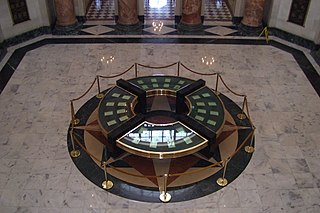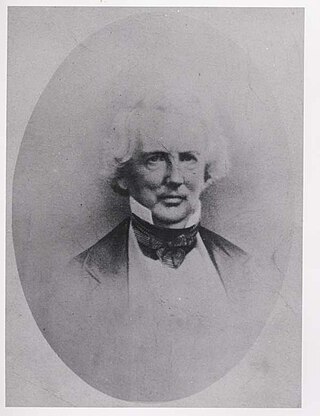
The Kentucky and Virginia Resolutions were political statements drafted in 1798 and 1799 in which the Kentucky and Virginia legislatures took the position that the federal Alien and Sedition Acts were unconstitutional. The resolutions argued that the states had the right and the duty to declare unconstitutional those acts of Congress that the Constitution did not authorize. In doing so, they argued for states' rights and strict construction of the Constitution. The Kentucky and Virginia Resolutions of 1798 were written secretly by Vice President Thomas Jefferson and James Madison, respectively.

The Presbyterian Church (USA), abbreviated PCUSA, is a mainline Protestant denomination in the United States. It is the largest Presbyterian denomination in the country, known for its liberal stance on doctrine and its ordaining of women and members of the LGBT community as elders and ministers. The Presbyterian Church (USA) was established with the 1983 merger of the Presbyterian Church in the United States, whose churches were located in the Southern and border states, with the United Presbyterian Church in the United States of America, whose congregations could be found in every state.

The Constitution of the Commonwealth of Puerto Rico is the controlling government document of Puerto Rico. It is composed of nine articles detailing the structure of the government as well as the function of several of its institutions. The document also contains an extensive and specific bill of rights. It was ratified by Puerto Rico's electorate in a referendum on March 3, 1952, and on July 25, 1952, Governor Luis Muñoz Marín proclaimed that the constitution was in effect. July 25 is known as Constitution Day.

The Presbyterian Church in the United States of America (PCUSA) was a Presbyterian denomination existing from 1789 to 1958. In that year, the PCUSA merged with the United Presbyterian Church of North America. The new church was named the United Presbyterian Church in the United States of America. It was a predecessor to the contemporary Presbyterian Church (USA).

The Reformed Presbyterian Church General Assembly (RPCGA) is a Presbyterian church body and conservative denomination in the United States established in 1991. The RPCGA was founded by members of the Reformed Presbyterian Church in the United States.

The Virginia Conventions have been the assemblies of delegates elected for the purpose of establishing constitutions of fundamental law for the Commonwealth of Virginia superior to General Assembly legislation. Their constitutions and subsequent amendments span four centuries across the territory of modern-day Virginia, West Virginia and Kentucky.

The South Carolina Declaration of Secession, formally known as the Declaration of the Immediate Causes Which Induce and Justify the Secession of South Carolina from the Federal Union, was a proclamation issued on December 24, 1860, by the government of South Carolina to explain its reasons for seceding from the United States. It followed the brief Ordinance of Secession that had been issued on December 20. The declaration is a product of a convention organized by the state's government in the month following the election of Abraham Lincoln as U.S. president, where it was drafted in a committee headed by Christopher Memminger.

South Carolina was the first state to secede from the Union in December 1860, and was one of the founding member states of the Confederacy in February 1861. The bombardment of the beleaguered U.S. garrison at Fort Sumter in Charleston Harbor on April 12, 1861, is generally recognized as the first military engagement of the war. The retaking of Charleston in February 1865, and raising the flag again at Fort Sumter, was used for the Union symbol of victory.

The Report of 1800 was a resolution drafted by James Madison arguing for the sovereignty of the individual states under the United States Constitution and against the Alien and Sedition Acts. Adopted by the Virginia General Assembly in January 1800, the Report amends arguments from the 1798 Virginia Resolutions and attempts to resolve contemporary criticisms against the Resolutions. The Report was the last important explication of the Constitution produced before the 1817 Bonus Bill veto message by Madison, who has come to be regarded as the "Father of the Constitution."
Nullification, in United States constitutional history, is a legal theory that a state has the right to nullify, or invalidate, any federal laws which they deem unconstitutional with respect to the United States Constitution. There are similar theories that any officer, jury, or individual may do the same. The theory of state nullification has never been legally upheld by federal courts, although jury nullification has.

The Old School–New School controversy was a schism of the Presbyterian Church in the United States of America which took place in 1837 and lasted for over 20 years. The Old School, led by Charles Hodge of Princeton Theological Seminary, was more conservative theologically and did not support the revival movement. It called for traditional Calvinist orthodoxy as outlined in the Westminster standards.

Gardiner Spring was an American minister and author. He served as pastor of the Brick Presbyterian Church in New York City for 63 years.
The U.S. state of Louisiana declared that it had seceded from the United States on January 26, 1861. It then announced that it had joined the Confederate States (C.S.); Louisiana was the sixth slave state to declare that it had seceded from the U.S. and joined the C.S.
The Mississippi Secession Ordinance was written by Lucius Quintus Cincinnatus Lamar (II), who resigned from the U.S. Congress in January 1861. The ordinance was signed by James Z. George and others.

The 1917 United States declaration of war on Austria-Hungary, officially House Joint Resolution 169, was a resolution adopted by the United States Congress declaring that a state of war existed between the United States of America and the Austro-Hungarian Empire. It occurred eight months after the earlier declaration of war against Germany that had brought the United States into World War I. Enacted on December 7, 1917 and coming into effect the same day, it was officially terminated in 1921, three years after the effective capitulation of Austria-Hungary.

The Virginia Secession Convention of 1861 was called in the state capital of Richmond to determine whether Virginia would secede from the United States, govern the state during a state of emergency, and write a new Constitution for Virginia, which was subsequently voted down in a referendum under the Confederate Government.
The Augusta Declaration, or the Memorial of Augusta County Committee, May 10, 1776, was a statement presented to the Fifth Virginia Convention in Williamsburg, Virginia on May 10, 1776. The Declaration announced the necessity of the Thirteen Colonies to form a permanent and independent union of states and national government separate from Great Britain, with whom the Colonies were at war.
The First North Carolina Provincial Congress was the first of five extra-legal unicameral bodies that met beginning in the summer of 1774. They were modeled after the colonial lower house. These congresses created a government structure, issued bills of credit to pay for the movement, and organized an army for defense, in preparation for the state of North Carolina. This First Congress met in New Bern from August 25 to August 27, 1774. John Harvey served as president. These Provincial congresses paved the way for the first meeting of the North Carolina General Assembly on April 7, 1777 in New Bern, North Carolina.
The First Woman's National Temperance Convention was a founding event in the establishment of the American Woman's Christian Temperance Union (WCTU).












